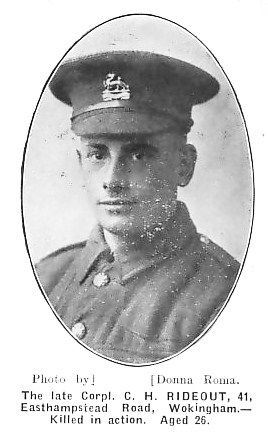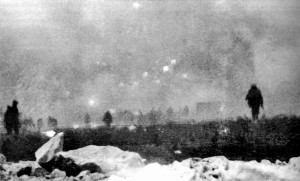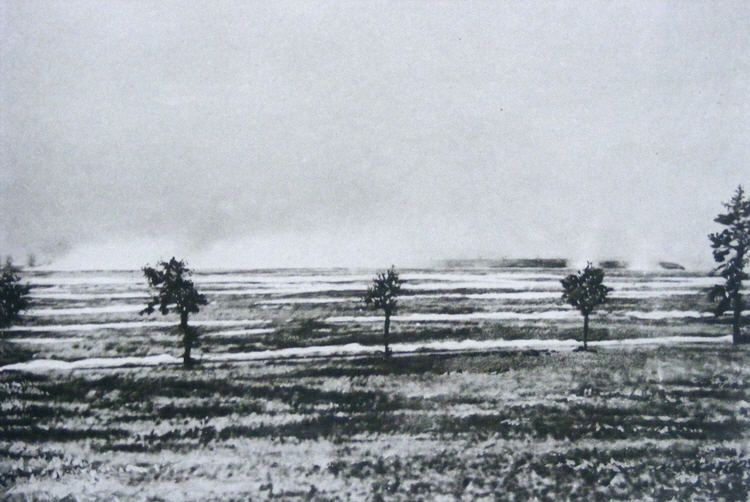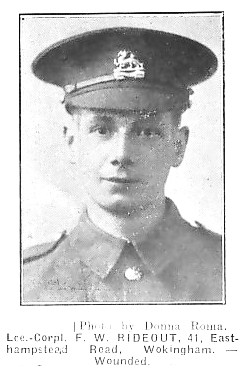
Charles Rideout died on the 25th September 1915 during the Battle of Loos. His body was never recovered
Today’s article focuses on the names listed on the Town Hall War Memorial and their part in a war which ultimately led to their deaths. This is the story of the Charles Rideout and the Battle of Loos in September 1915, one hundred years ago to the month.
Wokingham’s Town Hall Memorial in Market Square is a composite of four church memorials around the town and names 217 of the local servicemen who lost their lives in the First World War.
Thirty one of these Wokingham men died in 1915, most of them under the age of 25, during the Second Battle of Ypres, Gallipoli, Loos or else from sickness or occasional sniper fire. This is the story of one of those men.
Charles Rideout: 1891-1915
One hundred years ago in September 1915 a long forgotten battle was about to take place near to the village of Loos just to the south of Lille in northern France. The Battle of Loos was significant because it was the first time Kitchener’s volunteers entered the battlefield and the first time gas was used by the British army – with disastrous consequences. It was also the month when Charlie Rideout, a 25 year old harness maker who served in a shop in Peach Street Wokingham, was to lose his life.
Charlie was a well-known figure in Wokingham’s pre-war community; a keen cricketer and footballer and also working for a Mr Evans who owned the local harness makers at 19 Peach Street. Local historian Edna Goatley knew Charlie’s two sisters Florence and Winifred:

Photograph of actual attack from the British at Loos. The first attack was made under cover of smoke
“The Rideout laddie was a harness maker, he worked in Peach Street before volunteering. I was home help to his two sisters over 40 years ago. They talked of the last words he said to them.. “Look after Mum and Dad, because I won’t be back”. He was going back to the front line and knew of his chances of making it home again”.
Charles was killed on the 25th September 1915; Loos was a bloody battle and the attack of the 25th was the bloodiest. Corporal Read of Henley described the morning wait:
“It was awful. Never shall I forget it! I can well remember looking at my watch about five minutes before we had to leap out of our trenches. Those remaining minutes seemed like years but they had an ending. The whistles sounded all along the line and over we went to meet the awful fire of the Germans”
The Battle of Loos saw the first use of gas. A sergeant of the Berks 8th Battalion recounted later:
“On the Saturday the order was given to release the gas. Unfortunately there was not sufficient wind to carry it to the enemy trenches and a number of our men suffered considerably. About 20 minutes was allowed for the gas to settle and then the order was given for the advance”.
With the wind changing direction, the gas began to drift back across the 1st Division trenches. One of the 10th Glosters, a Private W Jennings, reported
“The gas caused a lot of trouble and men were lying in the trench bottom foaming at the mouth”.
The British had lost some 60,000 men and the Royal Berks themselves lost nearly 500 men; half the battalion.
We do not know of the exact circumstances of Charles’ death on this day and his body was never recovered. His loss was particularly hard on the Wokingham community; Charlie was one of the Bell ringers of St. Paul’s Church, and also a member of the Wokingham Town Band. A muffled peel was rung on the Sunday following the news of his death. The family had lost Charlie in 1915; his brother Frank was to return home badly injured and youngest brother Leslie was to die after the war aged just 21 years.
Summary of the Great War in 1915.
Battles at Ypres in Belgium in October 1914 and April of 1915 were not enough to force a conclusion to the war – even after the introduction of chlorine gas. Germany was fighting Russia on their eastern front, winning on the battlefield and choking supplies via the Black Sea. Churchill planned to open up the entrance to the Black Sea at the Dardanelles, but would need to break the resistance of the resident Turks first. After over 8 months in January 1916, the campaign failed on the peninsular of Gallipoli, inflicting losses of nearly 400,000 men from both sides.
Gallipoli represented a year of general failure for the Allies. By mid-1915 the professional army and the reserve forces had been virtually eliminated and the British war effort also was blighted by a lack of equipment and munitions, culminating in another failure at the Battle of Loos. At the end of 1915, Sir John French was replaced by Douglas Haig as Commander of the Armed Forces and along with the Government, the war effort began to be reorganised. The following year, Kitchener’s volunteer army was to face its greatest challenge on a hitherto quiet enclave on the River Somme.
Thanks to John Chapman, Jim Bell and Edna Goatley in the research for this article. For more information click on: Charles Rideout for his biography.


